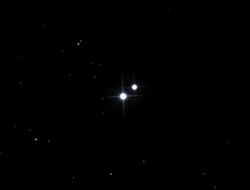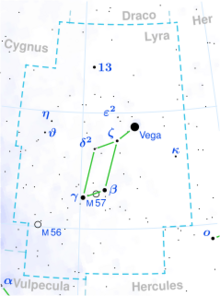Astronomy:Zeta1 Lyrae
| Observation data Equinox J2000.0]] (ICRS) | |
|---|---|
| Constellation | Lyra |
| Right ascension | 18h 44m 46.35735s[1] |
| Declination | +37° 36′ 18.4171″[1] |
| Apparent magnitude (V) | 4.37[2] |
| Characteristics | |
| Spectral type | kA5hF0mF2[3] |
| U−B color index | +0.17[2] |
| B−V color index | +0.18[2] |
| Astrometry | |
| Proper motion (μ) | RA: +29.04[1] mas/yr Dec.: +27.03[1] mas/yr |
| Parallax (π) | 20.89 ± 0.17[1] mas |
| Distance | 156 ± 1 ly (47.9 ± 0.4 pc) |
| Absolute magnitude (MV) | +0.94[4] |
| Orbit[5] | |
| Period (P) | 4.3 d |
| Eccentricity (e) | 0.01 |
| Periastron epoch (T) | 2440000.723 JD |
| Argument of periastron (ω) (secondary) | 0.00° |
| Semi-amplitude (K1) (primary) | 51.6 km/s |
| Details | |
| Mass | 2.36[6] M☉ |
| Radius | 2.5[7] R☉ |
| Luminosity | 31[8] L☉ |
| Surface gravity (log g) | 3.7±0.1[9] cgs |
| Temperature | 7914±112[9] K |
| Metallicity [Fe/H] | 0.38±0.06[9] dex |
| Rotational velocity (v sin i) | 47[10] km/s |
| Age | 500[6] Myr |
| Other designations | |
| Database references | |
| SIMBAD | data |
Zeta1 Lyrae, Latinized from ζ1 Lyrae, is a binary star in the northern constellation of Lyra. Based upon an annual parallax shift of 20.89 mas as seen from Earth,[1] the pair are located about 156 light years from the Sun. It is visible to the naked eye with an apparent visual magnitude of 4.37.[2]
Observational history

ζ1 Lyrae was discovered to be a spectroscopic binary by William Wallace Campbell and Heber Doust Curtis in 1905 from photographic plates taken at the Lick Observatory between 1902 and 1904.[12] The first orbit was calculated by Frank Craig Jordan of Allegheny Observatory in 1910 with results in good agreement with the most recent orbit.[13]
Several other faint stars within about an arc-minute have been listed as companions, but none are physically associated with ζ1 Lyrae.[14]
Binary system
This is a single-lined spectroscopic binary system with an orbital period of 4.3 days and a nearly circular orbit with an eccentricity of 0.01.[5] The primary, component A, is an Am star with a stellar classification of kA5hF0mF2. This complex notation indicates that the spectral type determined solely from the calcium K line would be A5, the spectral type determined from other metallic lines would be F2, and the type determined from hydrogen lines would be F0.[3]
Variability
ζ1 Lyrae appears to be slightly variable, with a frequency of 0.65256 cycles per day and an amplitude of 0.0032 in magnitude.[15] The star has an estimated 2.36[6] times the mass of the Sun and around 2.5[7] times the Sun's radius. The position of this system is associated with an X-ray source with a luminosity of 571.6×1020 W.[16]
References
- ↑ 1.0 1.1 1.2 1.3 1.4 1.5 van Leeuwen, F. (2007), "Validation of the new Hipparcos reduction", Astronomy and Astrophysics 474 (2): 653–664, doi:10.1051/0004-6361:20078357, Bibcode: 2007A&A...474..653V.
- ↑ 2.0 2.1 2.2 2.3 Mermilliod, J.-C. (1986), "Compilation of Eggen's UBV data, transformed to UBV (unpublished)", Catalogue of Eggen's UBV Data (SIMBAD), Bibcode: 1986EgUBV........0M.
- ↑ 3.0 3.1 Abt, Helmut A.; Morrell, Nidia I. (1995), "The Relation between Rotational Velocities and Spectral Peculiarities among A-Type Stars", Astrophysical Journal Supplement 99: 135, doi:10.1086/192182, Bibcode: 1995ApJS...99..135A.
- ↑ Anderson, E.; Francis, Ch. (2012), "XHIP: An extended hipparcos compilation", Astronomy Letters 38 (5): 331, doi:10.1134/S1063773712050015, Bibcode: 2012AstL...38..331A.
- ↑ 5.0 5.1 Pourbaix, D.; Tokovinin, A. A.; Batten, A. H.; Fekel, F. C.; Hartkopf, W. I. et al. (2004), "SB9: The ninth catalogue of spectroscopic binary orbits", Astronomy & Astrophysics 424 (2): 727–732, doi:10.1051/0004-6361:20041213, Bibcode: 2004A&A...424..727P.
- ↑ 6.0 6.1 6.2 De Rosa, R. J. et al. (2013), "The VAST Survey - III. The multiplicity of A-type stars within 75 pc", Monthly Notices of the Royal Astronomical Society 437 (2): 1216, doi:10.1093/mnras/stt1932, Bibcode: 2014MNRAS.437.1216D.
- ↑ 7.0 7.1 Pasinetti Fracassini, L. E.; Pastori, L.; Covino, S.; Pozzi, A. (February 2001), "Catalogue of Apparent Diameters and Absolute Radii of Stars (CADARS)", Astronomy and Astrophysics 367 (2): 521–524, doi:10.1051/0004-6361:20000451, Bibcode: 2001A&A...367..521P.
- ↑ McDonald, I. et al. (2012), "Fundamental Parameters and Infrared Excesses of Hipparcos Stars", Monthly Notices of the Royal Astronomical Society 427 (1): 343–57, doi:10.1111/j.1365-2966.2012.21873.x, Bibcode: 2012MNRAS.427..343M.
- ↑ 9.0 9.1 9.2 Prugniel, Ph. et al. (2011), "The atmospheric parameters and spectral interpolator for the MILES stars", Astronomy & Astrophysics 531: A165, doi:10.1051/0004-6361/201116769, Bibcode: 2011A&A...531A.165P.
- ↑ Royer, F. et al. (October 2002), "Rotational velocities of A-type stars in the northern hemisphere. II. Measurement of v sin i", Astronomy and Astrophysics 393 (3): 897–911, doi:10.1051/0004-6361:20020943, Bibcode: 2002A&A...393..897R.
- ↑ "* zet01 Lyr". SIMBAD. Centre de données astronomiques de Strasbourg. http://simbad.u-strasbg.fr/simbad/sim-basic?Ident=%2A+zet01+Lyr.
- ↑ Campbell, W. W.; Curtis, H. D. (1905), "A list of nine stars whose radial velocities vary", The Astrophysical Journal 21: 189, doi:10.1086/141200, Bibcode: 1905ApJ....21..185C.
- ↑ Jordan, Frank Craig (1910), "The orbit of ζ1 Lyrae", Publications of the Allegheny Observatory of the University of Pittsburgh 1 (17): 115–118, Bibcode: 1910PAllO...1..115J.
- ↑ Mason, Brian D. et al. (December 2001), "The 2001 US Naval Observatory Double Star CD-ROM. I. The Washington Double Star Catalog", The Astronomical Journal 122 (6): 3466–3471, doi:10.1086/323920, Bibcode: 2001AJ....122.3466M.
- ↑ Koen, Chris; Eyer, Laurent (2002), "New periodic variables from the Hipparcos epoch photometry", Monthly Notices of the Royal Astronomical Society 331 (1): 45–59, doi:10.1046/j.1365-8711.2002.05150.x, Bibcode: 2002MNRAS.331...45K.
- ↑ Schröder, C.; Schmitt, J. H. M. M. (November 2007), "X-ray emission from A-type stars", Astronomy and Astrophysics 475 (2): 677–684, doi:10.1051/0004-6361:20077429, Bibcode: 2007A&A...475..677S.
 |


